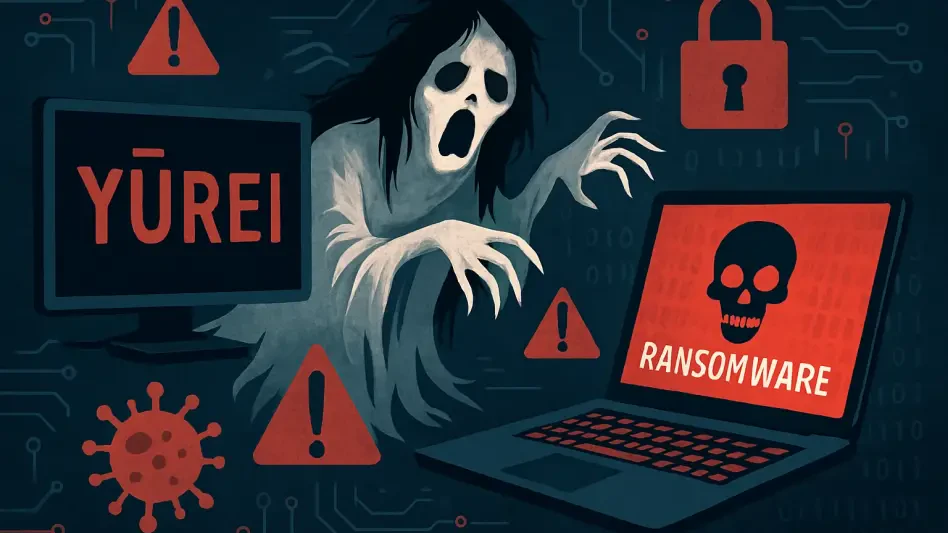In an era where cyberthreats evolve at an unrelenting pace, the emergence of Yurei ransomware serves as a stark reminder of how accessible tools can empower even novice attackers to inflict significant damage. First uncovered by Check Point Research on September 5 after targeting a Sri Lankan food manufacturer, Yurei has quickly gained notoriety for its cunning use of open-source malware to execute double-extortion attacks. This strategy, which involves both encrypting critical files and stealing sensitive data, places immense pressure on victims to pay ransoms to avoid operational downtime and public leaks. What makes this group particularly concerning is not just the audacity of their approach, but the ease with which they’ve adapted freely available code to strike across borders. This troubling trend underscores a broader shift in cybercrime, where the barrier to entry is lower than ever, enabling rapid escalation of threats against vulnerable industries. As ransomware continues to plague critical sectors, understanding Yurei’s methods offers vital insights into defending against this growing menace.
Unpacking Yurei’s Reliance on Open-Source Malware
Accessibility and the Democratization of Cybercrime
The foundation of Yurei’s operations lies in the exploitation of open-source malware, specifically a modified version of Prince-Ransomware coded in the Go programming language. Platforms like GitHub host such codebases, making them readily available to anyone with an internet connection, regardless of technical skill. This accessibility has fueled a democratization of cybercrime, allowing individuals with minimal expertise to repurpose existing tools for malicious intent. Yurei’s rapid rise, despite limited customization of the original framework, exemplifies how these resources lower the threshold for launching impactful attacks. The implications are profound, as the proliferation of such tools means that even small-scale actors can target organizations globally, exploiting vulnerabilities without needing to develop sophisticated malware from scratch. This trend challenges traditional cybersecurity assumptions, as defenders must now account for a wider pool of potential threats originating from less experienced but equally dangerous adversaries.
A deeper look into this phenomenon reveals how open-source malware serves as a double-edged sword in the cybersecurity landscape, offering both learning opportunities for researchers and developers to study and counter threats, while simultaneously equipping malicious actors with pre-built solutions that require little effort to deploy. In Yurei’s case, the group’s ability to strike a Sri Lankan food manufacturer and expand to other victims shortly after demonstrates the speed at which these tools can be weaponized. The ease of access to such codebases on public repositories also means that mitigation strategies must evolve to include proactive monitoring of these platforms for emerging threats. As more groups follow Yurei’s lead, the cybersecurity community faces the urgent task of balancing open knowledge-sharing with the risks of enabling cybercrime. This dynamic highlights the need for international cooperation to address the root causes of malware proliferation while strengthening defenses against opportunistic attackers.
Low-Effort Modifications, High-Impact Results
Yurei’s ransomware showcases how minimal alterations to open-source code can still yield devastating outcomes for targeted organizations, highlighting a growing concern in cybersecurity. The group made only slight tweaks to the Prince-Ransomware framework, yet managed to orchestrate attacks that disrupted operations across multiple countries within days. This low-effort approach underscores a critical reality: sophistication is not a prerequisite for success in the ransomware arena. By leveraging an existing, proven codebase, Yurei bypassed the need for extensive development, focusing instead on deployment and extortion tactics. The high impact of their attacks, despite rudimentary modifications, reveals the inherent potency of open-source malware when paired with strategic execution. This accessibility amplifies the threat landscape, as it enables a broader range of actors to exploit vulnerabilities without investing significant time or resources in crafting original tools.
Examining the specifics of Yurei’s modifications further illustrates the efficiency of their strategy in exploiting open-source resources, highlighting how minimal changes can yield significant impact in the realm of cybercrime. The group retained most of the original Prince-Ransomware structure, adapting just enough to suit their double-extortion model while avoiding complex reprogramming. This pragmatic approach allowed them to focus on scaling their operations, as evidenced by their quick expansion to victims in India and Nigeria following the initial Sri Lankan target. The success of such a low-barrier strategy signals a shift in cybercrime dynamics, where the emphasis lies not on technical innovation but on exploiting human and systemic weaknesses. For organizations, this means that defense mechanisms must prioritize rapid detection and response over merely anticipating highly advanced threats. The Yurei case serves as a cautionary tale, demonstrating that even basic adaptations of accessible malware can pose significant risks if left unaddressed by robust security measures.
Double-Extortion Tactics and Industry Impacts
Dual Pressure Through Encryption and Data Theft
Yurei’s adoption of a double-extortion model marks a sinister evolution in ransomware tactics, combining file encryption with the threat of data leakage to maximize coercion. By locking critical systems and simultaneously exfiltrating sensitive information, the group ensures that victims face a dual crisis: operational paralysis and potential reputational ruin. Even if backups allow for data restoration, the specter of stolen documents being published on Yurei’s darknet blog adds a layer of pressure that backups cannot mitigate. This blog, which lists victims and displays proof of compromise such as internal screenshots, serves as a public shaming tool while facilitating ransom negotiations through secure chat channels. The approach aligns with a wider ransomware trend where data theft has become a primary lever for extortion, shifting the focus from mere disruption to long-term damage through exposure of confidential information.
The psychological and financial toll of Yurei’s double-extortion strategy cannot be overstated, as it exploits both technical and emotional vulnerabilities of targeted entities, leaving them in a precarious position. Victims are often forced into a corner, weighing the cost of ransom against the fallout of leaked data, which could include trade secrets or personal information. This tactic is particularly effective against industries with high public accountability, where a breach can erode trust and trigger regulatory scrutiny. Yurei’s ability to weaponize stolen data via their darknet platform amplifies the urgency for organizations to secure not just their systems but also their data handling practices. The shift toward this model across the ransomware landscape signals a need for comprehensive strategies that address both encryption recovery and breach prevention. As such attacks grow in prevalence, the focus must expand to include robust data protection policies alongside traditional endpoint security measures to counter the multifaceted threats posed by groups like Yurei.
Operational Flaws and Persistent Danger
Despite Yurei’s early successes, their ransomware exhibits notable operational flaws that reveal a lack of technical finesse, particularly in failing to delete Volume Shadow Copies. These Windows backup snapshots can enable victims to restore encrypted files without succumbing to ransom demands, offering a potential lifeline for recovery. However, this oversight does not diminish the overarching threat of data exposure, which remains the group’s most potent weapon. The stolen information, often showcased on their darknet site as leverage, poses a risk that transcends operational downtime, threatening long-term harm through public disclosure. This persistent danger highlights a critical asymmetry in ransomware attacks: while technical errors may provide short-term relief, the strategic focus on data theft ensures that victims remain vulnerable to extortion even if systems are restored.
Further analysis of Yurei’s shortcomings sheds light on the evolving nature of ransomware threats and the opportunities they present for defense. The failure to eliminate recovery mechanisms like Volume Shadow Copies suggests that Yurei prioritizes speed and scalability over meticulous execution, a trait common among groups leveraging open-source tools. Yet, this gap does little to alleviate the core issue of data exfiltration, which continues to drive ransom payments as victims seek to prevent leaks. For cybersecurity professionals, these flaws offer a window to develop targeted countermeasures, such as ensuring backup integrity and educating users on recovery options. Nonetheless, the enduring risk of data exposure necessitates a broader approach, integrating advanced threat detection to identify breaches early and minimize the impact of stolen information. Yurei’s case illustrates that even imperfect attacks can inflict significant damage when paired with the right extortion tactics, underscoring the urgency for adaptive defenses.
Global Reach and Sector-Specific Vulnerabilities
Rapid Expansion Across Borders
Yurei’s ability to scale operations across international boundaries with alarming speed sets a troubling precedent for the reach of ransomware groups using open-source tools, and from a single attack on a Sri Lankan food manufacturer on September 5, the group expanded to three victims by September 9, affecting organizations in India and Nigeria. This swift proliferation demonstrates how accessible malware enables even small-scale actors to target diverse geographies without significant logistical barriers. Comparitech data reinforces this escalating threat, reporting a 7% increase in global ransomware incidents from July to August, signaling a broader surge in such attacks. The ease with which Yurei extended its footprint highlights the challenges of containing cyberthreats in a connected world, where digital tools erase traditional constraints of distance and jurisdiction, amplifying the potential for widespread disruption.
Delving into the mechanics of Yurei’s rapid expansion reveals the critical role of open-source malware in facilitating global attacks with minimal investment, highlighting a dangerous trend in cybercrime. By leveraging pre-existing code like Prince-Ransomware, the group sidesteps the need for extensive planning or infrastructure, focusing instead on identifying and exploiting vulnerable targets across regions. This efficiency is particularly concerning given the diversity of affected countries, which suggests a scattershot approach that prioritizes quantity over specificity. For defenders, this pattern underscores the importance of international collaboration in threat intelligence sharing to track and disrupt such groups before they gain traction. The Comparitech statistics further contextualize Yurei’s actions within a rising tide of ransomware, urging organizations to adopt proactive measures like real-time monitoring and cross-border partnerships to mitigate the risks of sudden, far-reaching campaigns launched by opportunistic actors.
Targeting Critical Sectors
Yurei’s choice of targets, particularly in industries like manufacturing and food and beverage, exposes the heightened risks faced by sectors integral to economic and societal stability. The initial attack on a Sri Lankan food manufacturer illustrates the potential for ransomware to disrupt supply chains and even impact food security, a concern amplified by the broader targeting of critical infrastructure. Manufacturing, in particular, has seen a 57% surge in ransomware claims from July to August, reflecting its vulnerability due to reliance on legacy systems and operational technology often lacking robust cybersecurity. These industries bear outsized consequences from attacks, as downtime can cascade through interconnected networks, affecting consumers and economies at large. Yurei’s focus on such sectors signals a strategic intent to maximize impact by exploiting systemic weaknesses.
Beyond the immediate operational fallout, the targeting of critical sectors by Yurei raises alarms about long-term societal implications that extend far beyond individual organizations. Healthcare, another frequently hit industry, faces risks to patient safety when systems are compromised, while disruptions in the food and beverage sector can threaten public welfare on a broader scale. The susceptibility of these sectors often stems from outdated infrastructure and budget constraints that hinder the adoption of modern security solutions. As ransomware groups increasingly prioritize high-stakes targets, the urgency for tailored defenses grows, requiring industry-specific protocols to safeguard operational continuity. Governments and private entities must collaborate to address these vulnerabilities, investing in resilience measures that protect not just data but the essential services these sectors provide. Yurei’s actions serve as a wake-up call, emphasizing that the stakes of cybercrime extend into the fabric of daily life, demanding a unified response to shield critical systems.
Technical Analysis and Defensive Strategies
Strengths and Weaknesses in Yurei’s Code
A technical breakdown of Yurei’s ransomware reveals a blend of modest innovation and significant oversight that shapes its threat profile, providing a clear picture of its capabilities and limitations in the cybersecurity landscape. By utilizing Go’s concurrency feature, known as goroutines, the group enhances the original Prince-Ransomware’s single-threaded design to encrypt multiple drives simultaneously, boosting the speed and efficiency of their attacks. This adaptation demonstrates a practical, if limited, improvement in execution, allowing for quicker system lockdowns that intensify pressure on victims. However, the failure to delete Volume Shadow Copies—a Windows feature that can store backup snapshots—exposes a critical vulnerability. Victims with these copies enabled may recover files without paying, offering a potential countermeasure to the encryption aspect of Yurei’s strategy. This mix of strengths and weaknesses highlights the uneven sophistication of open-source-based threats, where tactical gains can be offset by fundamental lapses.
Exploring further, the implications of Yurei’s technical profile provide valuable lessons for cybersecurity defenses against similar ransomware strains, highlighting critical vulnerabilities in their approach. The use of goroutines, while effective for rapid encryption, does not address the group’s inability to eliminate recovery options, a flaw that stems from either oversight or prioritization of other attack elements. This gap suggests that Yurei values speed over thoroughness, a common trait among groups relying on pre-built malware to scale operations quickly. For defenders, this presents an opportunity to focus on preserving and securing backup mechanisms like Volume Shadow Copies as a first line of recovery. Yet, this alone is insufficient, as the core threat of data theft persists regardless of encryption recovery. The technical analysis of Yurei’s ransomware underscores the need for a dual focus on mitigating immediate system impacts while addressing the broader risk of exfiltrated data, pushing organizations to adopt layered security approaches to tackle such multifaceted attacks.
Strategies for Mitigation
In response to the threats posed by Yurei and similar ransomware groups, Check Point Research advocates for a comprehensive, multi-layered security architecture to fortify organizational defenses. This approach includes integrating endpoint, network, and identity protection across hybrid and multi-cloud environments to create a cohesive shield against diverse attack vectors. Key measures involve deploying anti-phishing solutions to prevent initial access, enhancing user awareness through training to recognize sophisticated lures, and employing behavioral analytics to detect anomalies indicative of advanced threats. Additionally, proactive strategies like threat hunting and deception techniques can help identify malicious activity early, disrupting ransomware campaigns before they escalate. These combined efforts aim to address the accessibility of open-source malware by focusing on prevention and rapid response, ensuring that even low-skill attacks face significant barriers.
Beyond foundational security practices, effective mitigation against Yurei’s double-extortion model requires specific attention to data protection and recovery readiness. Organizations are urged to segment backups to limit the scope of encryption damage and regularly test restoration processes to ensure operational continuity under attack. Implementing strict access controls and monitoring for data exfiltration can also curb the impact of stolen information, reducing the leverage ransomware groups hold through public exposure threats. Furthermore, fostering a culture of cybersecurity hygiene, where employees are equipped to spot and report suspicious activity, serves as a critical human firewall. As ransomware evolves with tools like those used by Yurei, staying ahead demands continuous adaptation, leveraging both technological solutions and strategic planning. By building resilience through these actionable steps, entities can better navigate the persistent and shifting landscape of cyberthreats, safeguarding their operations and reputation against opportunistic attackers.








